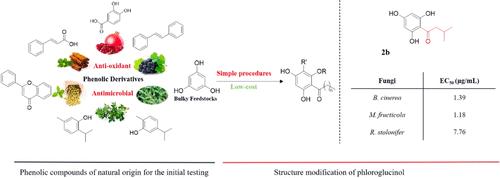Phloroglucinol 衍生物对灰葡萄孢菌和果糖单胞菌的抗真菌活性
IF 6.2
1区 农林科学
Q1 AGRICULTURE, MULTIDISCIPLINARY
引用次数: 0
摘要
天然提取的化合物有望治疗微生物感染。多酚广泛存在于各种植物、水果和蔬菜中,因其生理功效(包括抗菌作用)而备受关注。本研究介绍了一组新的酰化氯代葡萄糖醇衍生物,这些衍生物经过合成,并在体外对七种不同的致病真菌进行了抗真菌活性测试。其中最突出的化合物是 3-甲基-1-(2,4,6-三羟基苯基)丁-1-酮(2b),它具有显著的杀真菌能力,对灰葡萄孢菌的 EC50 值为 1.39 μg/mL,对果孢莫尼林菌的 EC50 值为 1.18 μg/mL,优于之前筛选出的酚类化合物。在体内测试时,2b 表现出了有效的抗真菌特性,在 200 μg/mL 的浓度下,对褐腐病的治愈率为 76.26%,对灰霉病的治愈率为 83.35%,在对灰霉病菌的防效方面可与商用杀菌剂嘧菌酯相媲美。初步研究表明,2b 的抗真菌机制可能包括破坏孢子萌发、破坏真菌细胞膜和细胞内容物的渗漏。这些结果表明,化合物 2b 对灰霉病菌具有很好的杀真菌性,具有治疗灰霉病的潜力。本文章由计算机程序翻译,如有差异,请以英文原文为准。

Antifungal Activity of Phloroglucinol Derivatives against Botrytis cinerea and Monilinia fructicola
Naturally derived compounds show promise as treatments for microbial infections. Polyphenols, abundantly found in various plants, fruits, and vegetables, are noted for their physiological benefits including antimicrobial effects. This study introduced a new set of acylated phloroglucinol derivatives, synthesized and tested for their antifungal activity in vitro against seven different pathogenic fungi. The standout compound, 3-methyl-1-(2,4,6-trihydroxyphenyl) butan-1-one (2b), exhibited remarkable fungicidal strength, with EC50 values of 1.39 μg/mL against Botrytis cinerea and 1.18 μg/mL against Monilinia fructicola, outperforming previously screened phenolic compounds. When tested in vivo, 2b demonstrated effective antifungal properties, with cure rates of 76.26% for brown rot and 83.35% for gray mold at a concentration of 200 μg/mL, rivaling the commercial fungicide Pyrimethanil in its efficacy against B. cinerea. Preliminary research suggests that 2b’s antifungal mechanism may involve the disruption of spore germination, damage to the fungal cell membrane, and leakage of cellular contents. These results indicate that compound 2b has excellent fungicidal properties against B. cinerea and holds potential as a treatment for gray mold.
求助全文
通过发布文献求助,成功后即可免费获取论文全文。
去求助
来源期刊
CiteScore
9.90
自引率
8.20%
发文量
1375
审稿时长
2.3 months
期刊介绍:
The Journal of Agricultural and Food Chemistry publishes high-quality, cutting edge original research representing complete studies and research advances dealing with the chemistry and biochemistry of agriculture and food. The Journal also encourages papers with chemistry and/or biochemistry as a major component combined with biological/sensory/nutritional/toxicological evaluation related to agriculture and/or food.

 求助内容:
求助内容: 应助结果提醒方式:
应助结果提醒方式:


